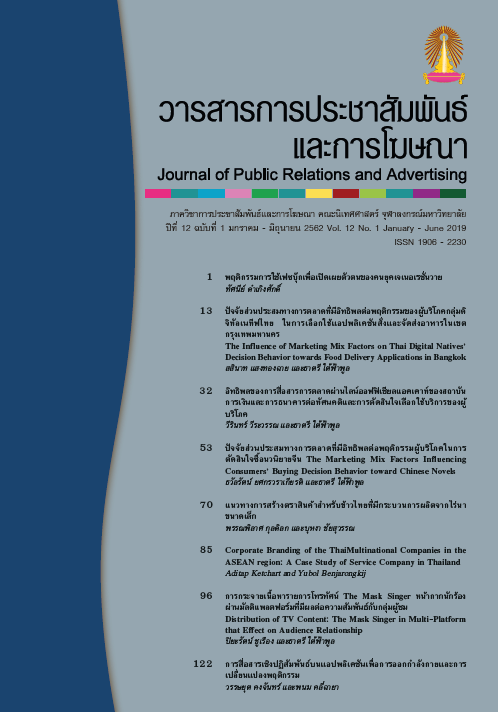The Marketing Mix Factors Influencing Consumers’ Buying Decision Behavior toward Chinese Novels
Main Article Content
Abstract
The purpose of the quantitative study was: 1.) to find out consumer’s exposure on Chinese novels, attitudes toward publisher’s marketing and buying decision behavior toward Chinese novels. 2.) to find out similarities and differences of demographic characteristics on consumer’s exposure on Chinese novels, attitudes toward publisher’s marketing and buying decision behavior toward Chinese novels 3.) to study the relationship between consumer’s exposure on Chinese novels, attitudes toward publisher’s marketing and consumers’ buying decision behavior toward Chinese novels 4.) to determine consumer’s exposure on Chinese novels and attitudes in influencing consumers’ buying decision behavior toward Chinese novels. Samples were 400 customers who had read Chinese novels by using checklists and rating questionnaire. The statistics used for data analysis were Independent Sample t-test, One -Way ANOVA, Pearson Correlation Coefficient and Multiple Regression Analysis.
The findings from the study revealed that the majority respondents were female, age between 30 – 35 years old, earned bachelor degree, worked for private sector companies and average monthly income higher than 25,000baht. From the study revealed that: 1.) The consumer exposure on Chinese novels was mostly through online. 2.) Consumers have mostly agreed upon attitudes towards publisher’s marketing mix in product. 3.) Plot of the novels impacts the consumers’ behavior buying decision behavior. 4). Sex is also a matter in experiencing the different media exposure. 5.) The consumers with different sexes, ages and income have different attitude towards publisher’s marketing mix significantly. 6.) The consumers with different sexes, ages and income have different buying decision behavior towards Chinese novels. 7.) The exposure on Chinese novels is positive significant and correlates with the attitude towards publisher’s marketing mix and consumers’ buying decision behavior which is in low level correlation coefficients. 8.) Attitudes towards publisher’s marketing mix is positive significant and correlates with consumers’ buying decision behavior in moderate level. 9.) The factors that influenced consumers’ buying decision behavior towards Chinese novels were the exposure on Chinese novels (Beta = 0.323) and attitudes toward publisher’s marketing mix. (Beta = 0.220)
Article Details
References
Marketeer. (2557). ตลาดหนังสือ. Retrieved from http://marketeer.co.th/archives/17312
โยรัม วินด์, &วีเจย์ มหาจาน. (2548). การตลาดลูกผสม =Convergence marketing (ทรงวิทย์ เขมเศรษฐ์ &หทัยชนก เตชะรัตนะวิโรจน์, Trans.). กรุงเทพมหานคร: สำนักพิมพ์ เอ.อาร์.ที. มีเดีย.
กาญจนา แก้วเทพ. (2547). ทฤษฎีและแนวทางการสื่อสารมวลชน. กรุงเทพมหานคร: ไฮเออร์เพรส.
กิ่งแก้ว ทรัพย์พระวงศ์. (2546). จิตวิทยาทั่วไป. กรุงเทพมหานคร ไทยเจริญการพิมพ์.
ชูชัย สมิทธิไกร. (2556). พฤติกรรมผู้บริโภค. กรุงเทพมหานคร: สำนักพิมพ์แห่งจุฬาลงกรณ์มหาวิทยาลัย.
ปรมะ สตะเวทิน. (2546). การสื่อสารมวลชน กระบวนการและทฤษฎี. กรุงเทพมหานคร: ภาพพิมพ์.
ประชาชาติธุรกิจ. (2560). สิ่งพิมพ์กระอัก ราคากระดาษพุ่ง 100 เหรียญสหรัฐต่อตัน ปรับราคาขายในประเทศ 5-10% ซ้ำเติมธุรกิจหนังสือ.ประชาชาติธุรกิจ. Retrieved from https://www.prachachat.net/news_detail.php?newsid=1493053853
พีอาร์นิวส์ไวร์. (2560). สำนักพิมพ์ไทยเร่งแปลนิยายออนไลน์จีน รองรับกระแสนิยมในวรรณกรรมออนไลน์แดนมังกร.
ศิริวรรณ เสรีรัตน์ และคณะ. (2534). การส่งเสริมการขาย. กรุงเทพมหานคร: ไทยวัฒนาพาณิช.
ศุภรัศมิ์ ฐิติกุลเจริญ. (2554). ทฤษฎีการสื่อสาร. กรุงเทพมหานคร: สำนักพิมพ์มหาวิทยาลัยเกษตรศาสตร์.
ส.พลายน้อย. (2548). สำนักพิมพ์สมัยแรก. กรุงเทพมหานคร: คอหนังสือ.
สมาคมผู้จัดพิมพ์และผู้จำหน่ายหนังสือแห่งประเทศไทย. (2560). Chinese Publication and Exhibition Tour in South East Asia. Retrieved from https://pubat.or.th/archives/495
สิทธิ์ ธีรสรณ์. (2552). การสื่อสารทางการตลาด. กรุงเทพมหานคร: สำนักพิมพ์แห่งจุฬาลงกรณ์มหาวิทยาลัย.
อดุลย์ จาตุรงคกุล, และดลยา จาตุรงคกุล. (2550). พฤติกรรมผู้บริโภค. กรุงเทพมหานคร: โรงพิมพ์มหาวิทยาลัยธรรมศาสตร์.
ภาษาอังกฤษ
Becker, S. L. (1972). Discovering Mass Communication. Illinois.: Scott Foresman and Company Glenview.
Burgoon, M. (1974). Approaching Speech/Communication (1 ed.). New York: Holt, Rinehart and Winston Inc.
Hanna, N., & Wozniak, R. (2001). Consumer Behavior: An Applied Approach. New Jersey: Prentice Hall.
Hoyer, W. D., & MacInnis, D. J. (2001). Consumer Behavior (2 ed.): Houghton Mifflin.
Jenkins, J. R. G. (1972). Marketing and Customer Behavior Oxford: Pergamon Press.
Klinger, M., & Greenwald, A. G. (1994). Preferences Need No Inferences?: The Cognitive Basis of Unconscious Mere Exposure Effects, 67-85. Retrieved from doi:10.1016/B978-0-12-410560-7.50010-7
Kotler, P. (2003). Marketing Management (11 ed.). New Jersey: Prentice Hall (Pearson Education).
Krech, D., & Crutchfield, R. S. (1948). Theory and Problem of Social Psychology. London: McGaw.
McCombs, M. E., & Becker, L. B. (1979). Using Mass Communication Theory. Englewood Cliff, New Jersey: Prentice Hall.
Schramm, W. (1954). The Process and Effects of Communication. Urbana, Illinois: University of Illinois Press.
Schramm, W. (1973). Channel and Audience in Handbook of Communication. Chicago: Renelly College Publishing Company.
Solomon, M. R. (2015). Consumer Behavior (11 ed.). England: Pearson Education.
Triandis, H. C. (1971). Attitudes and Attitude Change. New York: John Willy & Sons.


